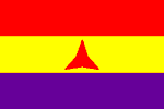Spain

Antonio Britz Martínez
Spain

Antonio Britz Martínez
The autumn of 1937 saw the establishment of the Grupo No 26 (I-15) and on 9 October 1937, capitán Juan José Armario Álvarez was appointed CO of the Grupo, which initially comprised three escuadrillas with 15 aircraft each.
The Soviet 1a Escuadrilla was led by Kapitan Yevgeniy Antonov and operated from Sagunto and Sabadel airfields, while teniente Gerardo Gil Sánchez headed up the Spanish 2a Escuadrilla (capitán Chindasvinto González García had handed over command to his deputy, Gil, to act as an interim CO). Both operated on the Aragon front. The Spanish 3a Escuadrilla was formed at Figueras under the command of teniente Juan Comas Borrás, which initially flew defensive patrols over the Catalan coast. The unit’s initial cadre of pilots consisted of Leopoldo Morquillas Rubio, Miguel Zambudio Martínez, Juan Olmos, José Redondo Martín, Antonio Britz Martínez, Rafael Sanromá Daroca and Antonio Nieto Sandoval-Díaz. Later, they were joined by José María Campoamor Peláez, Elías Hernández Camisón, Francisco Montagut Ferrer, Jesús Pérez Pérez, Alfredo de Albert Porcar and José Puig. Many of them were surviving pilots from the Northern front and later in the month the unit operated from Reus airfield.
Capitán Armario initially flew with the Soviet patrulla of the staff flight of the Grupo No 26, often accompanying Starshii Leitenant Stepanov.
On 10 December and in order to camouflage a planned Nationalist offensive towards Madrid on the Guadalajara, the Republican air forces were to be destroyed on their airfields east of Zaragoza. A Nationalist force of 88 bombers and 56 fighters took part in the operation. The slower bombers (SM.81s and Ju 52/3ms) were to attack the nearby airfields in the Barbastro zone; the faster bombers (SM.79s, Breguet 20s, He 111s and Do 17s) those at Sariñena, Bujaraloz, Candasnos, Puebla de Híjar, Selgua, Pomar, Lérida and Balaguer. The Condor Legion’s bombers, which had to operate from more distant bases, would require refuelling before making their return flight, and facilities were provided at Sanjurjo.
The attacks failed to achieve the desired success, however; the airfields were empty and about 70 fighters were waiting in the air. It must be said that the Republicans were very well prepared to deal with surprise air attacks. They had constructed a large number of airfields and at each was based at most a single squadron, its aircraft widely dispersed around the airfield perimeter. In addition, they had built a number of decoy airfield on with mock-up aircraft.
At least, the VI and XVI Gruppi of the Aviazione Legionaria took part in this combat and Tenente Corrado Santoro of the 31a Squadriglia (VI Gruppo) took part in an escort mission to bombers attacking Sariñena and Sottotenente Mario Visintini of the 25a Squadriglia (XVI Gruppo) took part in his first combat, firing at some enemy aircraft but without claiming anything.
At the end of the battle, the Italians claimed eight I-15s shot down for just one CR.32 lost and its pilot KIA when Sottotenente Vittorio Barberis of the 32a Squadriglia, was killed in action near Alcubierre when his CR.32 collided with I-15 CC-022, flown by Soviet pilot Mikhail Vasilhevich Kotyhov from the 1a/26. The latter pilot also perished.
Group 2-G-3, which was flying below the Italians, climbed to their assistance and claimed seven I-15s without losses.
1.J/88 was airborne, with 15 Bf 109s flying deep into enemy territory. They were attacked by 30 enemy fighters. Oberleutnant Harro Harder recounted:
”Another major action on December 10. The Fiats patrolled the front, we flew deep into enemy territory with fifteen Bf 109s. Fifteen Curtisses and fifteen Ratas climbed up in close formation. There was nothing else to do, we attacked repeatedly, but so many aircraft immediately dove on us that we were happy just to escape in one piece.”The German fighters didn’t claim anything during the day.
Miguel Zambudio Martínez (CO 3a/26) was promoted to capitán on 1 October 1938.
Later in the month, Zambudio was replaced as CO by teniente Antonio Nieto Sandoval-Díaz, with teniente Francisco Montagut Ferrer serving as his deputy.
The escuadrilla included José Santander Menéndez, Esteban Corbalán Marín, Sánchez López, José Falcó, Joaquín Tremosa Arnavat, Álvaro Muñoz, José Garre Solano, Alfredo de Albert, Mario Cuesta, Britz and Rafael Belda.
Britz ended the Spanish Civil War with 1 shared biplane victory, this one claimed while flying the Polikarpov I-15.
Claims:
| Kill no. | Date | Time | Number | Type | Result | Plane type | Serial no. | Locality | Unit |
| 1937 | |||||||||
| 10/12/37 | 1/2 | He 111 | Shared destroyed | I-15 | Aragon Front | 3a/26 |
Biplane victories: 1 shared destroyed.
TOTAL: 1 shared destroyed.
(a) He 111 from K/88, which was lost over Candasnos and the crew (Leutnant Friedrich-Karl Beucke, Leutnant Heinrich Klein, Feldwebel Anton Bergmann, Unteroffizier Fritz Brühl and Obergefreiter Alois Ehlen) were all KIA.
Sources:
Aces of the Legion Condor – Robert Forsyth, 2011 Osprey Publishing, Oxford, ISBN 978-1-84908-347-8
Fighter Pilots Of The Spanish Republic (Vol. 1) - Rafael A. Permuy López, Historica 36/39 no. 1, ISBN 84-87314-89-9
Spanish Republican Aces – Rafael A Permuy López, 2012 Osprey Publishing, Oxford, ISBN 978-1-84908-668-4
Additional information kindly provided by Stefano Lazzaro and Ludovico Slongo.


